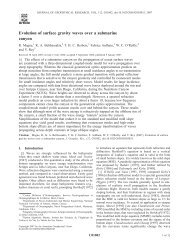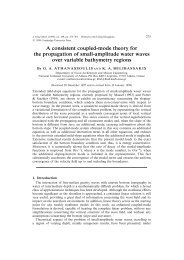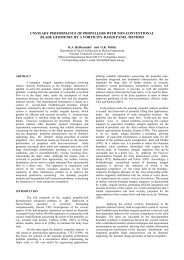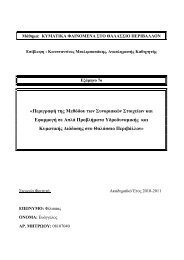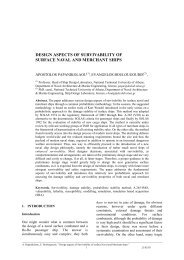Stockholm Agreement - Past, Present, Future (Part 2)
Stockholm Agreement - Past, Present, Future (Part 2)
Stockholm Agreement - Past, Present, Future (Part 2)
- No tags were found...
Create successful ePaper yourself
Turn your PDF publications into a flip-book with our unique Google optimized e-Paper software.
<strong>Stockholm</strong> <strong>Agreement</strong> – <strong>Past</strong>, <strong>Present</strong> & <strong>Future</strong> (<strong>Part</strong> II)Prof. Dracos Vassalos* & Prof. Apostolos Papanikolaou***The Ship Stability Research Centre, NAME, The Universities of Glasgow and Strathclyde, UK**National Technical University of Athens, Ship Design Laboratory, GreeceABSTRACTPage 1This paper provides a succinct summary of the findings ensuing the undertaking of a dedicated EUfundedresearch project aiming to address the impact of the <strong>Stockholm</strong> <strong>Agreement</strong> (SA) on the EURo-Ro passenger ships. This is achieved by utilising the experience gained, the data and knowledgeaccumulated through the adoption of the <strong>Stockholm</strong> <strong>Agreement</strong> in NW Europe to form the basis forpredicting the likely impact of introducing this <strong>Agreement</strong> to vessels operating in EU waters notcovered yet by it. The background, including a historical overview and a detailed introspective lookat the SA, together with an assessment of its impact on passenger Ro-Ro ships safety standards,design and operation are presented in a companion paper (<strong>Part</strong> I) in June 2002 issue of MT.INTRODUCTIONConcerted action to address the water-on-deck problem in the wake of the Estonia tragedy led IMOto set up a panel of experts to consider the issues carefully and make suitable recommendations.However, the complexity of the problem and the need to take swift action to reassure the public thatappropriate steps are taken to avoid a repeat of the Estonia disaster influenced to a large extent boththe initial and final proposals. Following considerable deliberations and debate (obviouslyunresolved), a new requirement for damage stability has been agreed only among the northwesternEuropean Nations to account for the risk of accumulation of water on the Ro-Ro deck. This newrequirement, known as the <strong>Stockholm</strong> <strong>Agreement</strong> [1] demands that a vessel satisfies SOLAS ‘90requirements (allowing only for minor relaxation) with, in addition, water on deck by considering aconstant height calculated as shown in Figure 1. The term Hs, characterising the operational seastate, pertains to the average of one-third highest waves (significant wave height, typically of unundeveloped sea – hence narrow banded), a statistical average correlating very well with theaverage of observed wave heights for a given sea state.The dates of compliance with the provisions of the agreement range from April 1, 1997 to October1, 2002. However, in view of the uncertainties in the current state of knowledge concerning theability of a vessel to survive damage in a given sea state, an alternative route has also been allowedwhich provides a non-prescriptive way of ensuring compliance, through the “Equivalence” route, byperforming experiments in accordance with the SOLAS ’95 Resolution 14, [2].Deriving from the above, numerical simulation models developed on the basis of systematicresearch over the past 15 years, [3] and capable of predicting with good engineering accuracy thecapsizal resistance of a damaged ship, of any type and compartmentation, in a realistic environmentwhilst accounting for progressive flooding were also used, offering the ferry industry the attractivepossibility of utilising such “tools” to assess the damage survivability of ferry safety, the so called“Numerical Equivalence” route. Numerical simulation readily allows for a systematic identificationof the most cost-effective and survivability-effective solutions to improving ferry safety and henceoffers a means for overcoming the deficiency of the physical model tests route in searching foroptimum solutions and an indispensable “tool” for the planning and undertaking of such tests.November 2001
Page 2Heightof Wateron Deck0.5H s =4.0 mH s =operational0.0H s =1.5 m0.3 2.0Residual FreeboardFigure 1: <strong>Stockholm</strong> <strong>Agreement</strong> (Height of water on Deck)October 1 2001 has therefore marked the beginning of the final year of the period initially allowedfor compliance with the <strong>Stockholm</strong> <strong>Agreement</strong> (SA) requirements, a period during which almost80% of the Ro-Ro fleet in North West Europe has been subjected to calculations, model testing andnumerical simulations on the way to meeting the new requirements pertinent to the <strong>Agreement</strong>. Theexperience gained has been invaluable in understanding better the problem at hand and is beingutilised to shape new developments for future Ro-Ro designs. All relevant details are presented in acritical overview of <strong>Stockholm</strong> <strong>Agreement</strong> from its inception to its implementation and ensuingimpact in a companion paper (<strong>Part</strong> I) in the June 2002 issue of MT.The North-South divide, however, continues to cause unrest, particularly at European level. Effortsto assess the status quo in North West Europe and use the information amassed so far as a means topredicting the potential impact of introducing the SA in the South, led to a dedicated call by theCommission and to a contract being awarded to two closely collaborating research teams in theNorth and South Europe, one at the Ship Stability Research Centre of the Universities of Glasgowand Strathclyde and the other at the Ship Design Laboratory of the National Technical University ofAthens. This study was finalised in March 2001 and a detailed technical report produced,describing comprehensively all the work undertaken, a brief account of which is presented herefollowing an outline description of the background and aims of the study and of the methodologyadopted in completing this work.THE SSRC-NTUA COMMISSION STUDYBackground and Aims of the StudyAt the conclusion of the second <strong>Stockholm</strong> Conference at which the <strong>Agreement</strong> was adopted, theCommission services issued a statement, taking note of the <strong>Agreement</strong> concluded and expressingthe opinion that the same level of safety should be ensured for all Ro-Ro passenger ferries operatingin similar conditions. Noting that the <strong>Agreement</strong> is not applicable to other parts of the EuropeanUnion, the Commission announced its intention to examine the prevailing local conditions,environmental and operational, under which Ro-Ro passenger ferries sail in all European waters andNovember 2001
Page 3that this examination will include the extent and effect of the application of the <strong>Agreement</strong> in theregion covered by it. The statement concluded that in light of this examination the Commissionwould make a decision with regard to the need for further initiatives and this statement wasconfirmed at subsequent meetings of the Council highlighting the need to ensure the same level ofsafety for all Ro-Ro ferries operating in similar conditions was more precisely defined by referringto both international and domestic voyages.Furthermore, in its latest proposal for Community legislation governing the safety of Ro-Ropassenger ships, the Commission included a draft provision that Ro-Ro ferries shall fulfil thespecific stability requirements adopted at regional level, when operating in the region governed bysuch regional rules. This proposal was endorsed by the Council with a number of adaptations toclarify that host States shall check that Ro-Ro ferries “comply with specific stability requirementsadapted at regional level, and transposed into their national legislation,….provided thoserequirements do not exceed those specified in the Annex of Resolution 14 (Stability RequirementsPertaining to the <strong>Agreement</strong>) of the 1995 SOLAS Conference and have been notified to theSecretary-General of the IMO, in accordance with the procedures specified in point 3 of thatresolution.”Taking fully into account the above elements, the Commission invited tenders to a study to examinethe extent and effect of the application of the <strong>Stockholm</strong> <strong>Agreement</strong> concerning specific stabilityrequirements for Ro-Ro passenger ships, and the suitability of extending its scope to Europeanwaters not covered by it. The contract to undertake this study was awarded to the NAME-SSRC/NTUA-SDL partnership. More specifically, the overall aim of the study was to assess theimpact of the <strong>Stockholm</strong> <strong>Agreement</strong> on European Ro-Ro passenger ships by targeting the followingtwo objectives:A. Impact assessment on the extent and the effect of the application of the <strong>Stockholm</strong> <strong>Agreement</strong>concerning specific stability requirements for Ro-Ro passenger ships in the area covered by it.B. Impact assessment on the extent and the effect of the application of the <strong>Stockholm</strong> <strong>Agreement</strong>concerning specific stability requirements for Ro-Ro passenger ships in European waters notcovered by it.Proposed MethodologyThe methodology adopted in completing this work is shown in Figure 2, explaining for each of thetwo distinct areas A and B the scope and approach to be followed to attain the results sought. Thestudy took one year to complete and produced two comprehensive technical reports addressing eachone of the two areas separately, [4], [5]. The key findings of this work are summarised here forareas A and B respectively, following the format of the adopted methodology.November 2001
Page 4IMPACT ASSESSMENT OF STOCKHOLM AGREEMENT METHODOLOGYAREA COVERED BY SAAEU WATERS NOT COVERED BY SABScope: Comparative analysis of NationalLegislation, particularly w.r.t. Article5(2) of the SA and one-compartmentships.Approach: DGVII, DGIII and NationalMaritime Administrations. A(a)Scope: Survey of prevailing sea conditionsand safety-critical local conditions, similarto those found in areas covered by SA.Approach: MEDGROUP study validatedwith Met Offices data and public domaindata on shipping statistics. B(a)Scope: Inventory of Ro-Ro passengervessels, categorised by A/Amax and Hs.Approach: Publications from UK andSwedish Administrations covering NorthSea and Baltic Sea, respectively.A(b)Scope: Inventory of Ro-Ro passengervessels operating in safety-critical areasand collection of relevant technical details.Approach: National MaritimeAdministrations, Flag States andcollaborating ferry operators.B(b)Scope: Inventory of all Ro-Roupgradings to comply with SA by31/12/99 and associated costs.Approach: National MaritimeAdministrations and collaborating ferryoperators.A(c)Scope: Establish which ships need to beupgraded to comply with SA and theextent of modifications.Approach: Use established trends of costsas a function of A/Amax and Hs and knowhow deriving from previous upgradings.B(c)Scope: Establish average compliancecost per vessel as a function of Hs foreach A/Amax category.Approach: Databases of SSRC andNTUA-SDL and use of in-house knowhow and expertise.A(d)Scope: Assessment of overall costs forcompliance with SA of all ships in B(b).Approach: Use of average costs together withknown trends and information based onupgradings and studies done so far.B(d)Scope: Assessment of overall cost, forcompliance with SA by 31/12/2002 latest,of all ships in A(b).Approach: Use of average costs togetherwith known trends and information basedon upgradings and studies done so far.A(e)Scope: Establish the time required toexecute the necessary modifications in EUyards.Approach: Information from EUROYARDSand collaborating ferry operators.B(e)Figure 2: Adopted Methodology for the SA StudyNovember 2001
Page 5AREA COVERED BY THE STOCKHOLM AGREEMENTKey FindingsAs shown in Figure 2, the study comprises five tasks, each forming part of the methodologyadopted as explained therein and summarised here below:Comparative Analysis of National Legislation A(a): The National Legislations of the countiesbeing parties to the SA were elaborated upon, aiming to: ascertain if the application of the SA isextended to Ro-Ro passenger ships entitled to fly the flag of States non-parties to the <strong>Agreement</strong>;assess the extent to which parties to the SA are bringing one-compartment Ro-Ro passenger ships incompliance with technical requirements of the SA as a matter of priority; identify if ContractingGovernments to the SA apply earlier implementation dates than those specified in Annex 2 to the<strong>Agreement</strong> for ships trading between their ports.The main results from task A(a) showed that, in the main, all countries affected by the SA haveapplied it without alterations. Exceptions to this are the UK and Norway. In the first case, it isinteresting to note that the UK also applies the <strong>Stockholm</strong> <strong>Agreement</strong> requirements to Ro-Ropassenger ships operating on comparable domestic seagoing routes (Class II(A)). In addition theUK decided that every ship to which the Merchant Shipping (High Speed Craft) Regulations 1996apply in so far as it implements Chapter 2 <strong>Part</strong> B of the High-Speed Code shall comply with therequirements of the <strong>Agreement</strong> relating to specific stability standards. In the second case, the<strong>Stockholm</strong> <strong>Agreement</strong> requirements apply to any Ro-Ro passenger ship to which SOLAS apply.As a result, every Norwegian Ro-Ro passenger ship should comply with the requirements of the SAon any voyage whether or not it is within the geographical area of the SA. Furthermore, additionalrequirements apply on the design of deck barriers. In all cases, no pertinent information can bediscerned addressing specifically issues pertaining to bringing either one- or two-compartmentvessels in compliance earlier than the compliance dates specified in Annex 2 to the <strong>Agreement</strong>.Also, it is to be noted that France is the only EU country, which whereas it is not one of thesignatories of the <strong>Agreement</strong>, it is partly affected by the latter, taking into account that a largenumber of French vessels operating in the channel were to be modified to comply with SArequirements.Inventory of Passenger Ro-Ro Vessels A(b): General information on Ro-Ro Passenger ships wascollated, along with relevant technical data, including information on compliance with relevantstability standards. The vessels were categorised by A/Amax and operational Hs. A comparisonbetween the databases corresponding to North EU (NEU) and South EU (SEU), respectively, led tothe following conclusions: the NEU fleet is generally younger (Figure 3) and has on the wholehigher stability standards than the SEU (Figure 4); it is also shown that the value of A/Amax of theNorth European fleet has risen considerably during the last five years, as a result of about 30% ofthe relevant vessels having already been upgraded to SOLAS ‘90 and to <strong>Stockholm</strong> <strong>Agreement</strong>standards by the beginning of the year 2000; by contrast, operational significant wave heightsvalues are generally evenly distributed throughout the EU fleet and are marginally higher in NEUthan the SEU (Figure 5, to be contrasted against Figure 10). As a general comment, it has beennoted that the experimental route to compliance with the <strong>Stockholm</strong> <strong>Agreement</strong> is normallypreferred (77% experimental route to 23% calculation route based on 79 upgraded vessels), sinceopting for this alternative enables ship owners to obtain a margin on the attained Hs for theirvessels, without increasing the complexity or cost of the upgrading. This margin is particularlyvaluable to ship owners, as it is likely to influence positively the resale value of their vessels.November 2001
Page 6Inventory of Passenger Ro-Ro Vessels Upgrading and Related Costs A(c): A comprehensiveinventory was undertaken of the technical modifications and adaptations carried out to all ferries,which had to comply with the SA by 31/12/99 or earlier, and of the associated costs. This part ofthe study showed that although a large number of the ships affected by SOLAS ‘90 and SA needmajor modifications in order to comply with these stability standards (80% major, 13% minor and7% none based on 61 vessels), a good part of these is due to the specific requirements related toSOLAS ’90 standard. Although this is not necessarily the case if larger values of operational Hsneed to be attained, in practice this indicates that the main effect of the SA in the NEU has been toaccelerate the schedule of compliance with SOLAS ‘90 requirements.Distributions of major and minor modifications are shown in Figure 6 whilst the cost distribution ispresented in Figure 7, this varying from €60k to €5.5M with an average of €2.1M per vessel, basedon 58 vessels.Average SA Compliance Cost for NEU Ro-Ro Vessels A(d): Studies aiming to establish averagecompliance cost per vessel as a function of the operational sea state and A/Amax category for agiven vessel were undertaken, based on the experience accumulated by the application of the SA inthe NEU. Statistical trends in this respect were established, which provided a useful input forevaluating the extent of modifications required by the SEU fleet. The results of this task (Figure 8),showed that: in the NEU there are comparatively more ships belonging to the lower upgrading costbrackets than to the higher ones; there is good correlation between average overall cost ofupgrading and GDP per capita (GDP per capita referring to the country in which the ship wasupgraded or – in absence of this information – the country where the ship operates from); cost ofupgrading and A/Amax values are well correlated and since there is good correlation between ageand A/Amax, it is reasonable to use the first as an indicator of a ship stability standard, all otherdata being unavailable; the variation of cost of modification with ship size is generally bestrepresented by a logarithmic law, GT seemingly giving the best fit to the data available; it isvirtually impossible to detect a trend of variation of cost of modification versus significant waveheight. It is to be noted that since the sample data available for achieving this task was limited, theregression linking the cost of upgrading to GT and A/Amax implied an unacceptably large error.For this reason, this analysis was repeated and verified in greater detail, as explained next.Assessment of Overall SA Compliance Cost for NEU Ro-Ro Vessels A(e): In this task it has beenattempted to further demonstrate and better quantify the link between upgrading cost and relevantparameters such as A/Amax and GT, continuing from the results presented in A(d) by using asample representing about 70% of the NEU fleet that needs to comply with the SA. On this basis,statistical trends were established, representative of the present status of the implementation of SAin the NEU, to be used for estimating on the whole the possible effect of introducing the SA toSEU. Furthermore, an estimate of the cost of the modifications still required to complete the SAupgrading in NEU was provided. In general this part of the project corroborate all the findings ofpart A(d), offering a better regression formula linking A/Amax and GT to overall cost of upgrading(Figure 9). Moreover, a detailed analysis of the cost of each type of modification has also beenattempted, leading to similar results in terms of overall cost of modifications per ship. On the basisof this analysis and estimating that about 28 vessels were still undergoing upgrading in the NEU,the total cost of the outstanding upgrading was calculated to be approximately €11.7M. This raisedthe total cost of upgrading of the NEU fleet to about €85M, with 36% of the fleet not requiring anyupgrading and about 69% of the vessels having been upgraded for less than €1.0M.November 2001
Page 7EU WATERS NOT COVERED BY THE STOCKHOLM AGREEMENTKey FindingsAs shown in Figure 2, the study comprises five tasks, each forming part of the methodologyadopted as explained therein and summarised here below:Survey of Prevailing Sea Conditions and Safety-Critical Local Conditions B(a): The prevailing seaconditions and other safety-critical local conditions in SEU geographical areas not covered yet bythe SA were investigated. The wave heights were determined following two alternative, yetessentially complementary, approaches. In the first approach the main ferry routes between portsinvolving at least one SEU state were analysed. In the second approach, whole geographicalregions have been associated with characteristic wave height values. Results of this study show(Figure 10) that relevant significant wave heights (Hs) in the Mediterranean are generally lowerthan 3.0m, with the exception of the region west of the island of Corsica where the obtained Hs wasapproximately 3.25m. However, larger wave heights, even exceeding 4.0m, were noted in theAtlantic routes to Madeira and the Azores. Concerning other, possibly safety-critical localconditions, such as wind, air and sea surface temperatures, visibility, traffic densities and othersimilar conditions it can be concluded, based on the collected data, that the local sea conditions areless safety-critical, when compared to the corresponding conditions in NEU waters, due to thehigher average air and sea surface temperatures and the generally less significant traffic densities inthe pertinent local areas.Inventory of Passenger Ro-Ro Vessels in SEU Waters B(b): A comprehensive inventory wasundertaken of Ro-Ro passenger vessels operating in SEU, along with relevant technical data,including information on compliance with relevant stability standards. The vessels werecategorized by means of a variety of technical, stability sensitive characteristics and economicindicators. It is to be noted that since information on A/Amax values for several registered vesselswas very limited (not available or not reliable), the relevant analysis was mainly based on thestability standard of compliance, thus providing indirectly an indication of the actual A/Amaxvalues of the vessels under consideration. Results are shown in Figures 3 and 4, where they arecontrasted against results from NEU vessels.Ships to be upgraded to Comply with SA B(c): The scope of this task was to establish which of theships that operate in SEU would need to be upgraded to comply with the provisions of The SA andthe possible extent of required modifications. Based on the inventory of the ships underinvestigation (Task B(b)), their current stability standard of compliance, area of operation (TaskB(a)) and corresponding A/Amax values, the results provided a categorisation of the affected shipsaccording to their current stability standards of compliance, relevant A/Amax values and year ofbuilt or major modification. On this basis, it was established which ships need to be upgraded inorder to comply with the SA, the extent of the required modifications in relation to relevantprovisions of the SOLAS regulations and the expected dates of compliance (if formally therequirements of the presently valid SOLAS ’90–2 compartment standard are met independently of apossible extension of the provisions of the SA to EU regions not covered by it), (Figure 11). Basedon the technical characteristics and the area of operation of the affected ships it was concluded thatthe techno-economic effort to upgrade these ships to SOLAS ‘90, 2-compartment standard, wouldnot deviate much from the effort required to ensure compliance with the provisions of the SA.November 2001
Page 8Assessment of Overall Cost of SEU Vessels for Compliance with SA B(d): The objective of thistask was to assess the costs associated with the necessary modifications of SEU Ro-Ro passengerships, identified and analysed under B(b) and B(c), for compliance with stability requirementssimilar to those of the SA. Taking into account that SEU Ro-Ro passenger ships are generallyoperating in waters of comparably lower Hs and also available scientific evidence indicating thatships complying with the SOLAS ‘90 standard will survive SOLAS damages of at least 2.5m Hs, asderived from model tests according to the “Equivalent Model Test Procedure” of Resolution 14,SOLAS ‘95, it has been concluded that the modification cost of SEU ships for compliance with theprovisions of the SA will be approximately the same as the associated cost for compliance with therequirements of the SOLAS ‘90 2-compartment standard. Based on the results of a detailed costanalysis of modifications for the NEU ships (task A(e)) and the derived regression formulae therein,the A/Amax values and GT values of the inventory ships and the GDP of the flag state, the itemisedcost/ship as well as the overall cost for the SEU ships has been deduced. Based on this, the totalmodification for the whole SEU fleet (264 ships) is estimated to range between a minimum of€106M and a maximum of €250M. It is to be noted that these estimates do not consider thepossible removal from service of aged SEU ships, which is to be expected since it might proveeconomically more advantageous for ship owners to replace some of these ships with new buildingsinstead of undertaking onerous extensive modifications.Assessment of Modification Time for Compliance of SEU Vessels with SA B(e): The objective ofthis task was to assess the time required to execute the necessary modifications for the affected SEUships, identified and analysed under B(b), B(c) and B(d), considering the capacity of Europeanshipyards, anticipated delivery times and the need to ensure continuity of service. Taking intoaccount the fact that the process of upgrading the affected ships is not a continuous function of timeand that the relevant shipping companies will rather choose to wait until it is absolutely necessary tomodify ships, it is concluded that the time required for the modifications will be strictly followingthe ‘phase in’ procedure for compliance with the provisions of <strong>Stockholm</strong> <strong>Agreement</strong>, to be decidedby the European Council. Therefore, the present task has been based on the assumption of anaccelerated compliance schedule for the affected SEU ships with the full provisions of SOLAS ‘90(Reg. 8-1 and Reg. 8-2) based on the deduction outlined in B(d) above. The assumed time schedule,ranging from 1 October 2002 for ships with lower values of A/Amax, to 1 October 2005 for those inthe highest A/Amax category, appears feasible in all respects, as this compliance schedule does notdeviate from the existing compliance with Regulation 1 of SOLAS ‘90 (provisions for onecompartment standard compliance). More importantly, this holds true for the large majority ofexisting vessels (78.1%, 235 out of 301 existing ships), whereas for the remaining ships alreadycomplying with Regulation 1, SOLAS ‘90 (21.9%, 66 out of 301 ships) the impact is considered tobe less severe and feasible within the set accelerated time schedule. From the point of view ofavailability and capacity of European shipyards in order to accomplish the requested modificationsand the seamless continuation of service, it can be concluded that, since the time schedule forcompliance with the provisions of SOLAS ‘90 is practically unchanged, no additional negativeeffects would result from the introduction of <strong>Stockholm</strong> <strong>Agreement</strong> in SEU. However, thefeasibility of the first compliance date being 1 October 2002 would need to be critically examined,considering that 59% of the ships identified for upgrading would be affected.CONCLUDING REMARKSThe North-South divide concerning safety of Ro-Ro passenger ships continues to trouble shippersand regulators alike and a way forward is actively being sought. Serving this need, an SSRC-NTUA partnership has undertaken on behalf of the European Commission a study to assess theNovember 2001
Page 9impact of the <strong>Stockholm</strong> <strong>Agreement</strong> on the areas covered by it with the view to evaluating thelikely impact of introducing it to areas not covered by it. This introspection on the <strong>Stockholm</strong><strong>Agreement</strong> led to the following key conclusions:• SOLAS ’90 ships appear to be capable of surviving sea states at least 2.5m Hs and thatSOLAS ’90 is a “good” standard reflecting meaningfully the safety of Ro-Ro vessels.• The <strong>Stockholm</strong> <strong>Agreement</strong> appears to be unrealistically stringent, in general demanding levelsof safety well beyond those determined through performance-based methods and, at times,simply unattainable.• Considering that a SOLAS ’90 ship survives 2.5 m Hs and accounting for the comparativelower Hs distribution in South European waters, it would appear that the upgrading cost to<strong>Stockholm</strong> <strong>Agreement</strong> would not be dissimilar to the cost and time for upgrading to SOLAS’90 2-compartment standard.• Projections based on the upgrading experience and incurred costs in North Europe reveal thatthe estimated overall cost of upgrading the South European fleet would be between €106Mand €250M.ACKNOWLEDGEMENTSThe authors would like to express their gratitude to the European Commission DG Transport for thefinancial support of the research described in this paper under Contract No. B99-B2702010-SI2.144738. The work was undertaken by two collaborating teams: the Ship Stability ResearchCentre team of the Universities of Glasgow and Strathclyde, comprising Prof. D. Vassalos, Dr. O.Turan, Dr. L. Letizia and Dr. D. Konovessis; the Ship Design Laboratory team of the NationalTechnical University of Athens, comprising Prof. A. Papanikolaou, Ass. Prof. K. Spyrou, Ms E.Eliopoulou and Ms A. Alissafaki.REFERENCES[1] IMO Resolution 14, “Regional <strong>Agreement</strong>s on Specific Stability Requirements for Ro-RoPassenger Ships” – (Annex: Stability Requirements Pertaining to the <strong>Agreement</strong>), adopted on29 November 1995.[2] IMO Resolution 14, “Regional <strong>Agreement</strong>s on Specific Stability Requirements for Ro-RoPassenger Ships” – (Appendix: Model test method), adopted on 29 November 1995.[3] Vassalos, D, Pawlowski, M and Turan, O, “A Theoretical Investigation on the CapsizalResistance of Passenger/Ro-Ro Vessels and Proposal of Survival Criteria”, Final Report, TheJoint North West European Project, University of Strathclyde, Department of Ship andMarine Technology, March 1996.[4] D. Vassalos, O. Turan, L. Letizia and D. Konovessis, “Impact Assessment of <strong>Stockholm</strong><strong>Agreement</strong> on EU Ro-Ro Passenger Vessels Covered by it”, (B99-B2702010-SI2.144738),Final Report <strong>Part</strong> I, NAME-SSRC, March 2001.[5] A. Papanikolaou, K. Spyrou, E. Eliopoulou and A. Alissafaki, “Impact Assessment of<strong>Stockholm</strong> <strong>Agreement</strong> on EU Ro-Ro Passenger Vessels not Covered by it”, (B99-B2702010-SI2.144738), Final Report <strong>Part</strong> II, NTUA-SDL, March 2001.November 2001
Page 11A.2659%SOLAS 602%SOLAS 7422%NEU-Original A/Amax NEU-Current A/Amax SEU-A/Amax1.051.00SOLAS 9067%0.95(NEU - 128 sampled vessels)A. 2655%SOLAS 604%A/Amax0.900.850.800.75SOLAS 7435%0.700.6517131925313743495561677379859197103109115121127133SOLAS 90/9254%(SEU - 85 sampled vessels)SOLAS 882%Figure 4a: Compliance with SOLAS RegulationsFigure 4b: Distribution of A/AmaxNovember 2001
Page 12Figure 5: Distribution of Hs is NEUNovember 2001
Page 13SIDE CASINGS6%SUBDIVISIONS12%BUOYANCY TANKS4%TRANSVERSEDOORS46%BUOYANCY TANKS15%MAKING ROOMS WTBELOW CD1%ADDITIONAL SUBD.14%CROSS-FLOODING ARG9%STERN BOXES0%HEELING TANKS7%INFLOODING VALVES1%BALLAST TANKS0%B/5 BULKHEADS4%FW TANKS0%SPONSONS/DUCKTAIL32%Figure 6a: Distribution of Major Modifications (NEU - 49 vessels)TANK RE-ARRANGEMENT10%MAKING ROOMS WT ONCD30%SMALL SIDE CASINGS7%CENTRE CAS. On CD2%STABILISING TANKS0%Figure 6b: Distribution of Minor Modifications (NEU - 53 vessels)60005000Overall Cost (kEURO)4000300020001000Average Overall Cost = €1335013579111315171921232527293133353739414345474951535557Ship sampleFigure 7: Distribution of Overall Cost of Upgrading (NEU – 58 sampled vessels)November 2001
Page 14(NEU - 58 sampled vessels)All Ships (South and North)Cost (kEURO)450040003500300025002000150010005000Average Overall Cost of ModificationsAOC/GDPUK France Netherlands Finland Sweden Norway Denmark120100806040200AOC/GDPA/Amax1.051.000.950.900.850.800.750.70 y = -0.0037x + 1.0060.65 R 2 = 0.49240.600 5 10 15 20 25 30 35AgeFigure 8a: Cost and Normalised Cost Distribution with CountryFigure 8b: A/Amax Vs. Vessel Age6000Cost A/Amax Log. (A/Amax) Log. (Cost)50006000y = 0.0614Ln(x) + 0.7659R 2 = 0.95031.200Overall Cost (kEURO)4000300020001000y = 828.35Ln(x) - 6747.6R 2 = 0.2092Overall Cost (kEURO)50004000300020001000y = -694.24Ln(x) + 3403R 2 = 0.19171.0000.8000.6000.400A/Amax00 10000 20000 30000 40000 50000 60000 70000-1000GT (tonnes)0.20000 5 10 15 20 25 30 35 40 45-10000.000Ship sample (NEU - 40 sampled vessels)Figure 8c: Cost of Upgrading Vs. GT (NEU - 40 sampled vessels)Figure 8c: Cost of Upgrading and A/Amax DistributionNovember 2001
Page 15500045004000Rationalised Overall Cost (Keuro)y = 0.0195x + 212.4R 2 = 0.666235003000250020001500100050000 50000 100000 150000 200000GDP Per Capita*GT*(1-Orig. A/Amax)Figure 9: Rationalised Overall Cost of Upgrading vs. GDP*GT*(1-A/Amax) (NEU - 84 sampled vessels)November 2001
Page 162.502.251.754.253.753m1.752.503.252.752.252.5m2.0m2.752.5mFigure 10: Distribution of Hs in SEUNovember 2001
Page 17Regulation 8-1Compliance of 2-comp std shipsRegulation 8-1Compliance conditionallyRegulation 8-2Compliance conditionally (Reg. 8-1)Oct 200030%Oct 19988%Oct 200532%Oct 200024%Oct 19988%Oct 200538%Oct 20040%Oct 20050%Oct 200214%Oct 20000% Oct 20123%Oct 201034%Oct 200219%Oct 200411%Oct 200219%Oct 200411%Oct 200635%Oct 200814%Figure 11a: Ships with Recorded A/Amax Values (37 2-compartment standard ships out of 54 with conditional compliance)Regulation 8-1 (simulated ships)Compliance of 2-comp std shipsRegulation 8-1 (simulated ships)Compliance conditionallyRegulation 8-2 (simulated ships)Compliance conditionally (Reg. 8-1)Oct 200031%Oct 20053%Oct 200414%Oct 200252%Oct 200265%Oct 20005%Oct 200516%Oct 200414%Oct 200643%Oct 20040%Oct 20050%Oct 20024%Oct 20123%Oct 20112%Oct 201023%Oct 200825%Figure 11b: Ships with Simulated A/Amax Values (101 2-compartment standard ships out of 148 with conditional compliance)November 2001
Page 1825201514.277GDP per capita, in kEUROsource: Eurostat21.39520.44916.95315.1111050Greece Spain France Italy PortugalFigure 12a: GDP per Country in SEUSouth European Ro-Ro Passenger FleetOverall cost of upgradingOverall Cost, in kEURO2000180016001400120010008006004002000Figure 12b: Overall Cost of Upgrading = 0.0195*(GDP Per Capita *GT*(1- A/Amax))+212.4±610.2November 2001



